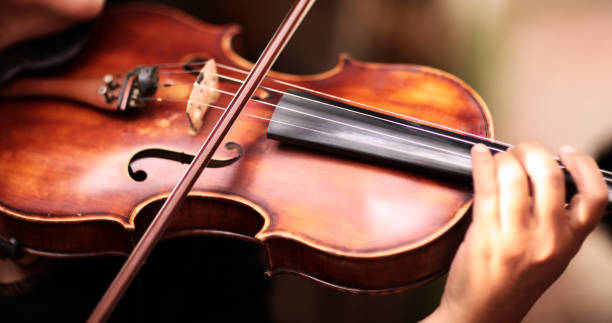
Can You Really Learn Violin by Yourself?
Common Doubts and Misconceptions
Many believe that learning the violin without a teacher is impossible. This is not true. With dedication and the right resources, you can teach yourself. Common doubts include:
- Can I learn the correct technique?
- Will I develop bad habits?
- Is it possible to progress without feedback?
You can learn proper techniques by using high-quality video tutorials and instructional books. These resources often provide step-by-step guidance. To avoid bad habits, record your practice sessions. Reviewing these videos can help you identify and correct mistakes.
Challenges and Rewards of Self-Teaching
Self-teaching the violin comes with challenges. However, the rewards are substantial.
Challenges:
- Self-discipline: Without a teacher, staying motivated can be tough.
- Finding resources: Quality learning materials are essential but can be hard to find.
- Lack of feedback: You need to find ways to get constructive criticism.
Rewards:
- Flexibility: You can set your own pace and schedule.
- Cost-effective: You save on the costs of hiring a teacher.
- Personal growth: Learning independently builds self-reliance and confidence.
Importance of Self-Discipline and Motivation
Self-discipline is crucial in self-teaching. Here are steps to stay disciplined and motivated:
- Set clear goals: Define what you want to achieve. Break it down into manageable steps.
- Create a practice schedule: Consistency is key. Dedicate specific times for practice.
- Track your progress: Keep a practice journal. Note what you practice and your improvements.
- Reward yourself: Celebrate milestones. Small rewards can keep you motivated.
- Find a community: Join online forums or groups. Sharing progress and challenges with others can be motivating.
Real-Life Examples of Successful Self-Taught Violinists
There are many successful self-taught violinists. They prove that with determination, you can achieve great things. Here are a few examples:
- David Garrett: A world-renowned violinist who started learning on his own before receiving formal training.
- Joshua Bell: Though he had teachers, his self-driven practice played a significant role in his success.
- Vanessa-Mae: Known for her unique style, she combined classical and contemporary music, much of which she learned on her own.
These violinists show that self-teaching can lead to professional success. They used structured practice schedules, high-quality resources, and self-discipline to achieve their goals.
Essential Steps to Start Your Violin Journey Alone

Choose the Right Violin and Equipment for a Beginner
Selecting the right violin is crucial for your success. Here’s how to choose the right equipment:
- Violin Size: Make sure to choose the correct size. Measure your arm length to find the right fit. Most beginners use a 4/4 (full-size) violin, but smaller sizes are available for younger players.
- Violin Type: Decide between an acoustic and an electric violin. Acoustic violins are traditional and good for beginners. Electric violins are more versatile but require an amplifier.
- Bow Material: Choose a bow with high-quality materials like Pernambuco or carbon fiber. These materials offer better balance and control.
- Strings: Start with synthetic strings. They are easier on the fingers and produce a warm sound.
- Rosin: Use light rosin for a smooth bowing experience.
- Accessories: Get a shoulder rest for comfort, a tuner for accurate tuning, and a hard case to protect your instrument.
Master the Basics: Holding the Violin, Bowing, and Tuning
Learning the basics is the foundation of playing the violin. Here’s how to start:
- Holding the Violin:
- Stand straight with relaxed shoulders.
- Place the violin on your left shoulder, resting your chin on the chin rest.
- Hold the violin’s neck lightly with your left hand.
- Bowing:
- Hold the bow with a relaxed but firm grip.
- Position your right hand with fingers slightly curved.
- Practice moving the bow across the strings in a straight line.
- Start with simple up-and-down strokes to get comfortable.
- Tuning:
- Use a digital tuner for accurate tuning.
- Tune each string (G, D, A, E) by turning the fine tuners or pegs.
- Check the pitch frequently and make adjustments as needed.
Learn to Read Music and Understand Basic Music Theory
Reading music and understanding music theory are essential skills for any violinist. Here’s a step-by-step guide:
- Learn the Staff:
- Understand the lines and spaces of the musical staff.
- Memorize the notes on the staff: G, D, A, E (for violin strings).
- Understand Note Values:
- Learn the different note values: whole, half, quarter, eighth, and sixteenth notes.
- Practice counting the beats for each note type.
- Recognize Key Signatures:
- Study the key signatures and their corresponding sharps and flats.
- Start with simple keys like G major and D major.
- Read Simple Melodies:
- Practice reading simple melodies and playing them on your violin.
- Use beginner sheet music and gradually increase complexity.
Find Reliable Learning Resources and Materials
Finding quality resources is vital for self-learning. Here are some tips:
- Books:
- Invest in instructional books for beginners. Look for books that cover basics, techniques, and exercises.
- Online Tutorials:
- Use video tutorials from reputable sources. Websites like YouTube offer free lessons from experienced violinists.
- Follow step-by-step guides to learn specific techniques and songs.
- Practice Apps:
- Use practice apps to track your progress and stay motivated. Apps like Tunable and Metronome can help with tuning and timing.
- Sheet Music:
- Download beginner sheet music. Start with simple pieces and gradually move to more challenging compositions.
- Online Communities:
- Join online forums and communities. Engage with other self-taught violinists for support and advice.
Effective Practice Routine for Self-Taught Violinists
Create a Structured Practice Schedule
Creating a structured practice schedule helps you stay organized and focused. Here’s how to do it:
- Set Clear Goals:
- Define short-term and long-term goals.
- Break down goals into weekly and daily targets.
- Allocate Time:
- Decide how much time you can dedicate to practice each day.
- Aim for at least 30 minutes to an hour of practice daily.
- Divide Practice Sessions:
- Warm-up (5-10 minutes): Start with simple exercises to loosen your fingers and arms.
- Technical exercises (10-20 minutes): Focus on scales, arpeggios, and finger exercises.
- Repertoire practice (20-30 minutes): Work on pieces you are learning.
- Cool down (5-10 minutes): End with slow and relaxing pieces.
- Stay Consistent:
- Practice at the same time every day to build a habit.
- Keep a practice journal to track your progress.
Balance Technical Exercises with Musical Pieces
Balancing technical exercises with musical pieces ensures comprehensive learning. Here’s how to balance your practice:
- Technical Exercises:
- Scales and Arpeggios: Practice major and minor scales in different keys. Incorporate arpeggios to improve finger strength and dexterity.
- Bow Exercises: Work on bowing techniques like legato, staccato, and spiccato.
- Finger Exercises: Use exercises like Schradieck or Sevcik to improve finger agility and coordination.
- Musical Pieces:
- Choose Appropriate Repertoire: Select pieces that match your skill level. Start with simple melodies and gradually progress to more complex pieces.
- Focus on Expression: Pay attention to dynamics, phrasing, and articulation.
- Break Down Difficult Passages: Isolate and repeat challenging sections until you master them.
- Integration:
- Alternate Focus: Spend time on technical exercises and then switch to musical pieces. This helps apply technical skills in a musical context.
- Set Practice Goals: For each session, set specific goals for both technical exercises and repertoire.
Incorporate Ear Training and Improvisation
Ear training and improvisation are crucial for developing musicality. Here’s how to incorporate them into your practice:
- Ear Training:
- Interval Recognition: Practice identifying intervals by ear. Use online tools or apps for guided exercises.
- Melody Playback: Listen to simple melodies and try to play them by ear.
- Pitch Matching: Play a note on the piano or another instrument and match the pitch on your violin.
- Improvisation:
- Start Simple: Begin with simple improvisation over a single chord or scale.
- Use Backing Tracks: Play along with backing tracks to practice improvising in different styles.
- Explore Different Keys: Improvise in various keys to improve versatility.
- Experiment with Techniques: Try different bowing techniques, dynamics, and articulations while improvising.
Seek Feedback and Constructive Criticism
Getting feedback is vital for improvement. Here’s how to seek constructive criticism:
- Record Yourself:
- Audio and Video: Record your practice sessions and performances. Reviewing recordings helps identify areas for improvement.
- Regular Reviews: Set aside time each week to review your recordings and make notes on what to improve.
- Join Online Communities:
- Forums and Groups: Participate in online violin forums and groups. Share your recordings and ask for feedback.
- Virtual Masterclasses: Enroll in virtual masterclasses where you can get feedback from experienced violinists.
- Practice Partners:
- Find a Partner: Look for other self-taught violinists or musicians to practice with. Exchange feedback and support each other’s progress.
- Online Collaboration: Use video calls to practice and get real-time feedback from practice partners.
- Professional Feedback:
- Periodic Lessons: Consider taking occasional lessons from a professional violinist to get expert advice.
- Workshops and Clinics: Attend workshops and clinics to get feedback from professionals and peers.
Overcoming Challenges in Self-Taught Violin Learning

Dealing with Frustration and Plateaus
Frustration and plateaus are normal in any learning process. Here’s how to handle them:
- Acknowledge the Feeling:
- Understand that frustration is part of learning.
- Recognize when you hit a plateau.
- Break Tasks into Smaller Steps:
- Divide difficult pieces into manageable sections.
- Focus on one section at a time.
- Set Short-Term Goals:
- Create specific, achievable goals for each practice session.
- Celebrate small victories to stay motivated.
- Change Your Approach:
- Try different practice methods or techniques.
- Use a metronome to slow down difficult passages.
- Take Breaks:
- Step away from the violin for a short period.
- Engage in other musical activities to refresh your mind.
- Seek Inspiration:
- Watch performances by professional violinists.
- Listen to new music to reignite your passion.
Finding Motivation and Staying Consistent
Staying motivated and consistent is key to progress. Here’s how to maintain your drive:
- Create a Routine:
- Set a regular practice time each day.
- Make practice a non-negotiable part of your daily routine.
- Track Progress:
- Keep a practice journal to note improvements and challenges.
- Review your journal to see how far you’ve come.
- Set Realistic Goals:
- Define both short-term and long-term goals.
- Adjust goals as needed to keep them attainable.
- Reward Yourself:
- Set up a reward system for reaching milestones.
- Treat yourself after a successful practice session.
- Find a Practice Partner:
- Collaborate with other musicians for mutual support.
- Share goals and achievements to stay accountable.
- Stay Inspired:
- Watch videos of skilled violinists.
- Attend live concerts or virtual performances.
Building Good Posture and Avoiding Injuries
Proper posture is essential to avoid injuries and play effectively. Here’s how to maintain good posture:
- Stand or Sit Correctly:
- Keep your back straight and shoulders relaxed.
- Distribute your weight evenly on both feet or sit upright.
- Hold the Violin Properly:
- Rest the violin on your left shoulder.
- Support the neck lightly with your left hand.
- Hold the Bow Correctly:
- Grip the bow with a relaxed but firm hold.
- Keep your wrist flexible.
- Warm Up:
- Start with gentle stretches for your arms, hands, and fingers.
- Begin each session with simple exercises.
- Take Breaks:
- Avoid long practice sessions without breaks.
- Stretch and relax your muscles during breaks.
- Monitor Your Body:
- Pay attention to any pain or discomfort.
- Adjust your posture and technique to avoid strain.
Mastering Difficult Techniques and Passages
Mastering difficult techniques and passages requires focused practice. Here’s how to tackle them:
- Isolate Problem Areas:
- Identify challenging sections in your music.
- Practice these sections separately.
- Slow Practice:
- Slow down the tempo to ensure accuracy.
- Gradually increase the speed as you improve.
- Use a Metronome:
- Practice with a metronome to maintain a steady rhythm.
- Adjust the tempo to match your skill level.
- Focus on Technique:
- Pay attention to your bowing and finger placement.
- Ensure your movements are precise and controlled.
- Repeat and Refine:
- Repeat difficult passages multiple times.
- Refine your technique with each repetition.
- Get Feedback:
- Record yourself and listen for areas of improvement.
- Share recordings with others for constructive criticism.
The Role of Online Communities and Resources
Join Online Violin Forums and Communities
Online forums and communities are excellent places to connect with other violinists. Here’s how to get involved:
- Find Reputable Forums:
- Violinist.com: A popular forum for violinists of all levels. It offers discussions on techniques, performances, and resources.
- Reddit: Subreddits like r/violin provide a platform for sharing experiences and asking questions.
- Create an Account:
- Sign up on these forums to participate in discussions.
- Introduce yourself and share your goals and experience level.
- Engage with Members:
- Ask questions and share your progress.
- Offer advice and support to others.
- Join Discussions:
- Participate in threads related to your interests.
- Share your challenges and seek feedback.
- Utilize Forum Resources:
- Explore pinned posts and resources shared by members.
- Download practice schedules, sheet music, and instructional guides.
- Follow Forum Rules:
- Read and adhere to the forum guidelines.
- Be respectful and constructive in your interactions.
Utilize Video Tutorials and Online Lessons
Video tutorials and online lessons are valuable for visual and practical learning. Here’s how to make the most of them:
- Find Quality Channels:
- YouTube: Channels like Violin Tutor Pro and Fiddlerman offer comprehensive lessons.
- Udemy: Paid courses provide structured lessons from experienced instructors.
- Create a Playlist:
- Organize videos into playlists based on topics like techniques, pieces, and exercises.
- Follow a sequence that matches your skill level and goals.
- Follow Along:
- Practice along with the videos.
- Pause and rewind to understand difficult sections.
- Take Notes:
- Write down important points and tips.
- Keep a practice journal to track what you learn from each video.
- Practice Regularly:
- Dedicate time each day to practice what you’ve learned.
- Review previous lessons to reinforce knowledge.
- Engage with Instructors:
- Leave comments and ask questions on videos.
- Join live sessions if available for real-time interaction.
Find Practice Partners and Playmates Online
Practicing with others can enhance your learning experience. Here’s how to find practice partners online:
- Join Online Groups:
- Facebook groups and Discord servers dedicated to violinists.
- Look for groups focused on your skill level and interests.
- Post Requests:
- Share a post looking for practice partners.
- Specify your goals and availability.
- Use Collaboration Platforms:
- Platforms like JamKazam and Acapella allow for online music collaboration.
- Set up virtual practice sessions with other violinists.
- Schedule Regular Sessions:
- Agree on regular practice times.
- Use video calls for live practice and feedback.
- Share Resources:
- Exchange sheet music and practice tips.
- Collaborate on learning new pieces.
- Support Each Other:
- Provide constructive feedback.
- Celebrate each other’s progress and achievements.
Explore Virtual Music Schools and Masterclasses
Virtual music schools and masterclasses offer structured learning from experts. Here’s how to explore these options:
- Enroll in Courses:
- Websites like MasterClass and ArtistWorks offer courses by renowned violinists.
- Choose courses that align with your goals and skill level.
- Follow the Curriculum:
- Adhere to the course structure.
- Complete assignments and exercises provided.
- Attend Live Sessions:
- Participate in live classes and Q&A sessions.
- Engage with instructors and peers during these sessions.
- Access Course Materials:
- Download lesson plans, sheet music, and practice guides.
- Use these materials for structured practice.
- Get Feedback:
- Submit recordings for review by instructors.
- Apply the feedback to improve your technique.
- Join Alumni Groups:
- Connect with other course participants.
- Share experiences and continue learning together.
When to Consider Professional Lessons

While self-teaching the violin is possible, there are times when professional lessons can provide significant benefits. Here’s how to recognize when you might need a teacher and how to balance self-study with professional guidance.
Recognize the Limitations of Self-Teaching
Self-teaching has its limitations. Recognizing these can help you decide when to seek professional help.
- Technical Challenges:
- Certain techniques, like vibrato or advanced bowing, can be difficult to master on your own.
- Misunderstanding a technique can lead to bad habits that are hard to break.
- Lack of Feedback:
- Without feedback, you might not notice mistakes.
- Constructive criticism is essential for improvement.
- Inconsistent Progress:
- Self-taught learners may experience uneven progress.
- Professional guidance can help maintain a steady learning curve.
- Motivation Issues:
- It’s easy to lose motivation without external support.
- Regular lessons provide structure and accountability.
- Limited Resources:
- You might miss out on valuable resources and methods.
- Teachers often have access to advanced learning materials.
Evaluate Your Progress and Goals
Evaluating your progress and setting goals is crucial in determining if you need a teacher.
- Assess Your Skills:
- Record yourself playing and compare it to previous recordings.
- Identify areas where you have improved and areas that need work.
- Set Specific Goals:
- Define what you want to achieve in the next few months.
- Break down these goals into smaller, manageable tasks.
- Seek Feedback:
- Share your recordings with online communities for feedback.
- Use this feedback to identify areas that require professional help.
- Identify Sticking Points:
- Recognize if you are stuck on certain techniques or pieces.
- Persistent issues may indicate the need for a teacher.
- Review Your Practice Routine:
- Ensure your practice routine is balanced and effective.
- Adjust your routine based on your progress and feedback.
Find Qualified Violin Teachers in Your Area
Finding a qualified teacher is crucial for effective learning. Here’s how to find the right one:
- Research Local Teachers:
- Look for teachers with good reviews and credentials.
- Ask for recommendations from local music stores or schools.
- Check Qualifications:
- Ensure the teacher has formal training and experience.
- Look for teachers who specialize in your skill level and goals.
- Interview Potential Teachers:
- Schedule a meeting or trial lesson.
- Discuss your goals and assess their teaching style.
- Consider Online Options:
- If local options are limited, consider online lessons.
- Platforms like Zoom or Skype can connect you with teachers worldwide.
- Ask for References:
- Request references from current or former students.
- Contact these references to learn about their experiences.
Balance Self-Study with Professional Guidance
Balancing self-study with professional lessons can maximize your learning.
- Set a Lesson Schedule:
- Decide how often you will take lessons (weekly, bi-weekly).
- Maintain consistency to build a routine.
- Prepare for Lessons:
- Practice assigned pieces and techniques before each lesson.
- Come with questions and topics you need help with.
- Incorporate Feedback:
- Apply the feedback and corrections given by your teacher.
- Focus on improving specific areas highlighted during lessons.
- Continue Self-Study:
- Use the skills and techniques learned in lessons during self-practice.
- Explore additional resources and materials on your own.
- Set Joint Goals:
- Work with your teacher to set realistic and achievable goals.
- Track progress together to stay motivated and on track.
Conclusion
Learning the violin by yourself is achievable with dedication and the right approach. Start by choosing the appropriate violin and mastering the basics of holding, bowing, and tuning. Create a structured practice routine, balancing technical exercises with musical pieces, and incorporate ear training and improvisation. Utilize online communities and resources for support and motivation. Recognize when to consider professional lessons, especially when facing technical challenges or motivation issues. Finding a qualified teacher can provide the necessary feedback and guidance to enhance your progress. Stay motivated by setting clear goals, tracking progress, and engaging with others. Consistency, quality resources, and a balance of self-study and professional guidance are key to mastering the violin. Embrace the journey, stay persistent, and enjoy learning and improving. Happy playing!
FAQs
Can I really learn the violin by myself?
Yes, you can learn the violin by yourself with dedication and the right resources. Many successful violinists have started as self-taught musicians. Utilize online tutorials, instructional books, and practice regularly to develop your skills.
What are the essential steps to start learning the violin on my own?
- Choose the right violin and equipment.
- Master the basics: holding the violin, bowing, and tuning.
- Learn to read music and understand basic music theory.
- Find reliable learning resources and materials.
- Create a structured practice schedule and stay consistent.
How can I create an effective practice routine?
- Set clear goals and allocate specific practice times.
- Balance technical exercises with musical pieces.
- Incorporate ear training and improvisation.
- Seek feedback from recordings and online communities.
What should I do when I face challenges in learning the violin?
- Break tasks into smaller steps to manage frustration.
- Set short-term goals and reward yourself for progress.
- Maintain good posture to avoid injuries.
- Focus on mastering difficult techniques through repetition and slow practice.
How can online communities and resources help me?
- Join online forums and communities to connect with other violinists.
- Utilize video tutorials and online lessons for visual and practical guidance.
- Find practice partners and collaborate online.
- Explore virtual music schools and masterclasses for structured learning.
When should I consider taking professional violin lessons?
- Recognize the limitations of self-teaching, such as technical challenges and lack of feedback.
- Evaluate your progress and goals to identify areas needing improvement.
- Find qualified violin teachers in your area or online.
- Balance self-study with professional guidance to maximize your learning experience.